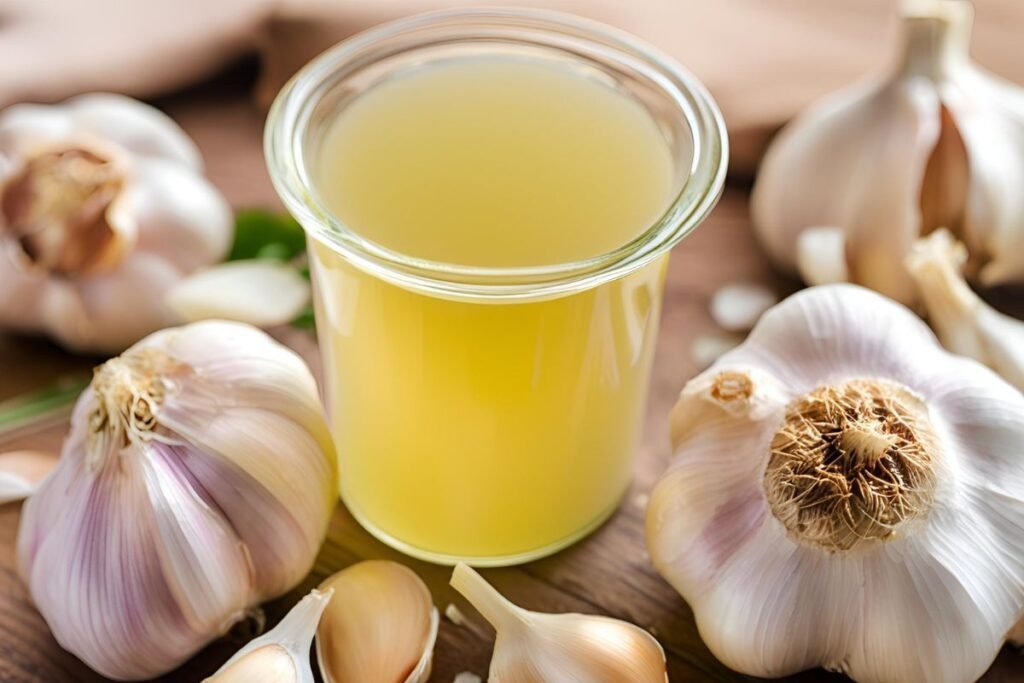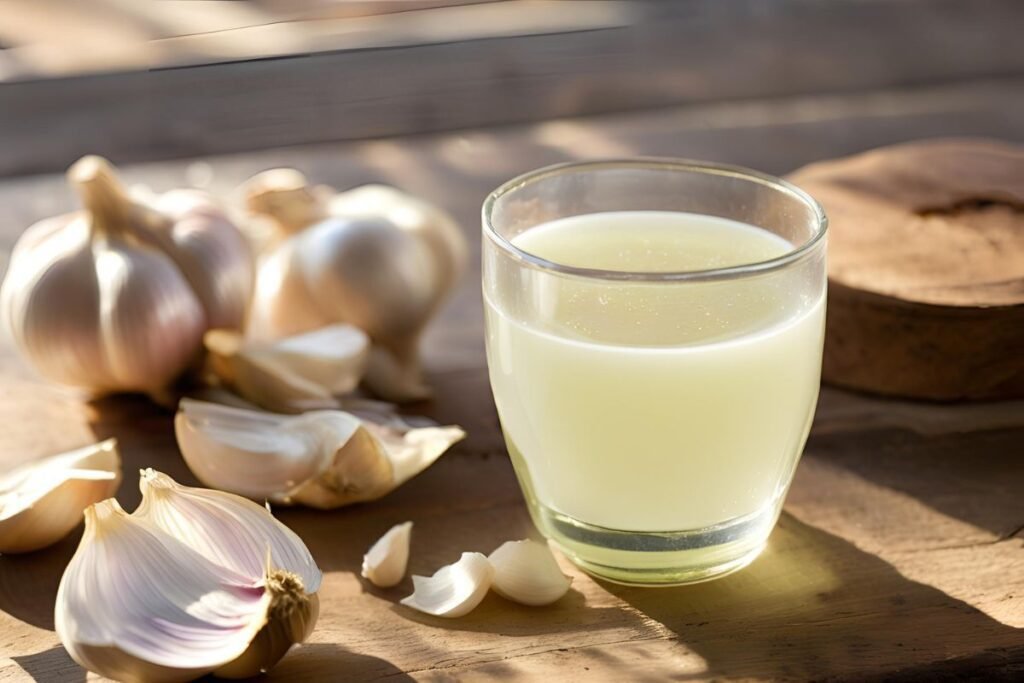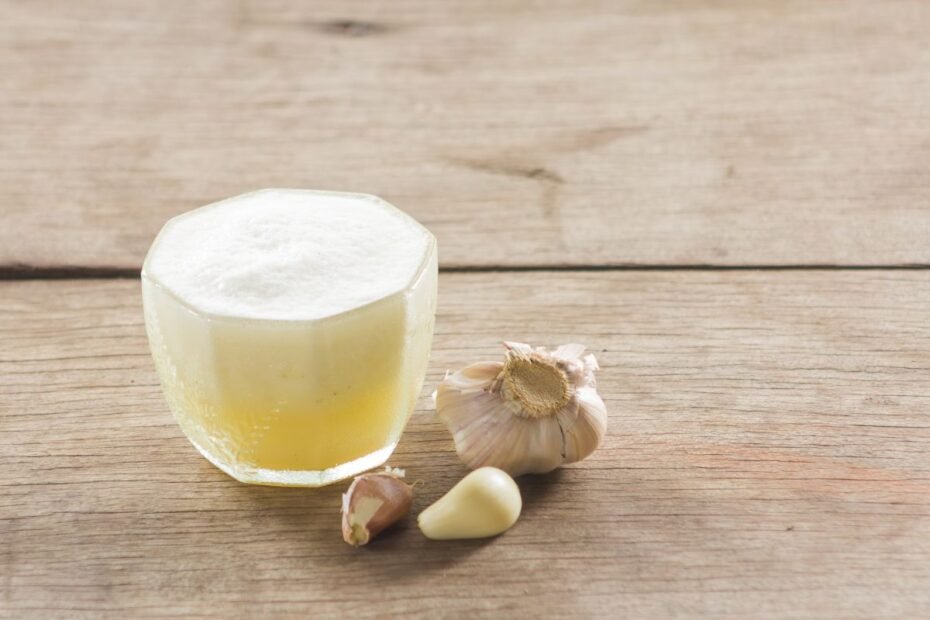Few people would think of savoring garlic juice, as this product has a different purpose. While garlic juice is a liquid extracted from fresh garlic cloves, it is so concentrated that drinking it like a regular beverage is impossible. However, this juice offers unique properties that you can use for health prevention or as a therapeutic cosmetic remedy. Let’s explore everything about this juice—from its nutritional and medicinal benefits to its preparation, dosage, usage, and potential side effects.
How May You Describe Garlic Juice?
Garlic juice is known for its highly intense taste, aroma, and other striking characteristics, all closely tied to the natural properties of garlic itself. It has a sharply pungent flavor with an accompanying robust, burning sensation. Some people may find the juice slightly bitter if using overripe garlic. Nevertheless, fresh garlic juice contains a subtle sweetness, although the pungency overshadows that.
The aromatic properties are just as intense as the flavor. Garlic juice emits an extraordinarily sharp and distinctive smell that can even be acrid. This odor is long-lasting and may cling to the skin or surroundings; due to this property, you should wear gloves when pressing garlic juice. Additionally, consuming larger quantities of garlic can result in an unpleasant breath or body odor noticeable to yourself and those around you.
When you squeeze out a splash of fresh garlic juice, notice its pale-yellow color. If left to sit for a while, the juice may darken slightly due to oxidation. Occasionally, due to interaction with metals or other substances, the juice might develop a bluish or greenish tint, but this is not harmful.

Unique Compounds in Garlic Juice
Garlic juice is rich in biologically active compounds that give garlic its distinctive aroma, flavor, and therapeutic properties, contributing significantly to its health benefits. Here are some of the key components:
- Organosulfur Compounds. The most characteristic chemical compounds in garlic are sulfur-based substances such as allicin, alliin, ajoene, and vinyldithiins. These consist of about 70–80% of the bioactive compounds in garlic. Garlic releases these components while it is chopped or crushed. Sulfur compounds—particularly allicin—are responsible for garlic’s strong smell, pungent taste, and many health-promoting properties, such as powerful anti-inflammatory and antifungal effects.
- Phenols and Flavonoids. Compared to other vegetable juices, garlic (and its juice) contains up to 20 times more polyphenols. Dominant compounds are β-resorcylic acid, pyrogallol, gallic acid, rutin, protocatechuic acid, quercetin, and luteolin. They exhibit strong antioxidant properties, help neutralize free radicals in the body, reduce oxidative stress, and support overall health.
- Other Components. Garlic juice also contains unique enzymes, such as alliinase, which activate the breakdown of sulfur compounds. According to scientific studies, garlic bulbs contain around 184 active secondary metabolites. It has 70 organosulfur compounds, 29 saponins, 16 flavonoids, 10 phenylpropanoids, 7 alkaloids, 3 fatty acid derivatives, and several selenium-containing compounds.
The chemical composition of garlic juice can vary depending on the garlic variety, growing conditions, and processing methods. For instance, scientific research has shown that purple garlic varieties contain up to 40 times more saponins than white garlic. It possesses several unique compounds not found in other types. Additionally, higher sulfur levels in the soil can increase the concentration of alliin in garlic. These compounds give garlic its unique aroma and flavor and contribute to its medicinal properties, such as antibacterial, antifungal, antioxidant, and immunomodulatory effects.
What Is the Nutritional Value of Garlic Juice?
You already know garlic juice is rich in biologically active compounds, but what specific nutritional benefits does it offer? Approximately 100 ml of garlic juice provides around 41 kilocalories, making it a low-calorie addition to your diet. It contains 9.3 grams of carbohydrates and polysaccharides, of which 85% is fructose, 14% glucose, 1% galactose, and about 1.5% dietary fiber. This composition offers a modest energy boost while contributing to digestive health due to its fiber content.
Garlic juice also contains 1.8 grams of protein per 100 ml, comprising 17 amino acids, 8 of which are essential. It means that your body cannot synthesize them, and they must be obtained from your diet. Garlic juice is very low in fats, with only 0.1 grams per serving, making it suitable for low-fat diets.
Garlic juice is a surprising source of essential vitamins. It contains vitamin C, providing about 34% of the recommended daily intake (RDI), which supports immune function and acts as a powerful antioxidant. Additionally, it is rich in B vitamins, including thiamine (B1), riboflavin (B2), niacin (B3), and pyridoxine (B6) (which stands out by offering up to 92% of the RDI).
Garlic juice is full of vital minerals, contributing to overall health and wellness. These include calcium and selenium (providing about 26% of the RDI), potassium, phosphorus, and manganese.
Together, this nutrient profile makes garlic juice a potent health tonic and a valuable nutritional supplement, supporting a wide range of bodily functions, from immune defense to metabolic health.

Health Benefits of Garlic Juice
Many people recognize garlic juice for its health benefits. It has antibacterial, anti-inflammatory, antioxidant, and other therapeutic properties, all based on the action of bioactive compounds present in garlic. Below are the key health effects of garlic juice supported by scientific research:
Antibacterial and Antifungal Effects
The primary active compound in garlic, allicin, is known for its potent antibacterial and antifungal properties. Studies show garlic effectively kills harmful bacteria such as Escherichia coli, Staphylococcus aureus, Candida albicans, and other pathogenic bacteria and fungi.
Cardiovascular Health
This juice helps protect the circulatory system and heart in a variety of ways, including improving blood pressure and lowering cholesterol levels. Scientific research has demonstrated that garlic can reduce systolic and diastolic blood pressure by up to 10 mmHg compared to placebo groups. Additionally, researchers observed cholesterol-lowering effects, showing that garlic reduces total cholesterol and LDL cholesterol levels.
Antioxidant Properties
Garlic juice is rich in antioxidants. It neutralizes free radicals and protects cells from oxidative stress. This helps reduce the risk of chronic diseases such as cancer and diabetes, as antioxidants play a key role in preventing cellular damage caused by oxidative processes.
Anti-inflammatory Effects
The sulfur compounds in garlic juice help inhibit inflammatory processes in the body. This can be particularly beneficial for individuals with inflammatory diseases (such as arthritis), as reducing inflammation can relieve symptoms and improve joint health.
Immune System Support
Garlic is beneficial for stimulating immune system activity. Research shows that regular consumption of garlic juice can reduce the duration and severity of colds and flu. Its immune-boosting properties are attributed to its ability to enhance the body’s natural defense mechanisms.
Anticancer Properties
Garlic juice may treat or even prevent the development of tumors. Animal studies and research on colorectal, breast, and lung cancer cell cultures suggest that the organic sulfur compounds can inhibit the growth of cancer cells, showing promise in cancer prevention and management.
Digestive Health
Garlic juice can improve digestion by promoting the growth of beneficial bacteria in the gut and reducing the population of harmful pathogens. This helps maintain a healthy gut microbiome.
Blood Sugar Regulation
Some studies suggest garlic juice helps reduce blood glucose levels and improve insulin sensitivity, making it beneficial for individuals with diabetes. This effect can aid in better blood sugar control and potentially reduce the risk of diabetes complications.

How to Make Garlic Juice in Two Simple Steps
You don’t need a degree to extract garlic juice. It helps to know that one garlic clove roughly equals one teaspoon of juice, so you can quickly and easily make this product. You will need:
- 10–15 cloves of fresh garlic (about 100 g)
Instructions:
- Peel the garlic cloves and rinse them well under running water. Soak the garlic in warm water for 5 minutes before pressing to reduce the odor and sharpness.
- Crush the peeled garlic cloves using a blender with a drop of water, or a juicer, or crush them with a garlic press and strain the juice through a cheesecloth/fine sieve.
- Pour the resulting liquid into an airtight glass container and store it in the refrigerator for up to 3 days.

Garlic Juice Dosing
You’ve probably already realized that garlic juice is not a product designed to maintain the body’s fluid balance. This liquid is like a supplement with proper dosing and moderation. The amount of garlic juice depends on the goal (prevention, treatment, or culinary use) as well as individual health conditions, but here are some general guidelines:
- For prevention: The recommended dose is 1–2 teaspoons (5–10 ml)/day, best consumed in the morning on an empty stomach or before a meal, followed by a glass of water.
- For health benefits. This juice is often used as a natural remedy to boost immunity, fight infections, reduce blood pressure, or lower cholesterol. In this case, drink 5–10 ml of garlic juice, mixed with honey or lemon juice, 1–2 times/day.
- For treatment purposes (such as regulating cholesterol), 10 ml of fresh garlic juice daily can have a positive effect.
- For cosmetic use. When using this juice as a cosmetic treatment, dilute it with water at a ratio of 1:2 and apply it locally. Diluted garlic juice is sometimes used for scalp massages to promote hair growth or combat dandruff. It can also serve as a remedy for acne and skin inflammation. People have tried garlic juice to reduce skin hyperpigmentation, treat scars, and strengthen nails.
- In cooking: you can garnish sauces, marinades, salads, or soups by adding garlic juice to give them a strong garlic flavor. The typical amount is 1–2 teaspoons, used as a seasoning.

Garlic Juice and Side Effects
Garlic juice is a powerful and versatile natural remedy for health, but it’s vital to use it in moderation due to potential side effects. Here are the main possible side effects:
- Digestive issues, such as abdominal pain, heartburn, nausea, diarrhea, or stomach irritation, are caused by the irritating sulfur compounds.
- Bad breath and body odor.
- Allergic reactions.
- Increased bleeding risk, as garlic has blood-thinning properties.
- Interaction with medications that lower blood pressure. It poses a risk of hypoglycemia or increases the risk of bleeding.
- Skin and mucous membrane irritation. Direct contact of garlic juice with the skin can cause redness, irritation, or even burns due to its strong chemical properties.
Sources
- https://www.frontiersin.org/journals/immunology/articles/10.3389/fimmu.2024.1277074/full
- https://core.ac.uk/download/pdf/153414692.pdf
- https://www.mdpi.com/2072-6643/12/3/872\
- https://pmc.ncbi.nlm.nih.gov/articles/PMC6678835
- https://www.wikihow.com/Make-Garlic-Juice
Associative photos © Canva.
